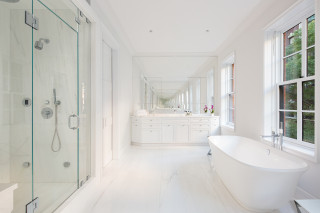Posted by Leonard Steinberg, President of COMPASS, on May 16th, 2015
Every morning, 365 days of the year, I post a daily contemplation to my fellow colleagues at COMPASS and today I wanted to share one:
SUBURBIFICATION AND THE CITY
I hate to admit this, but when I lived in Dallas many years ago, one of my more enjoyable off-duty outings was heading out to the suburban mall, especially North Park Mall. Not only could I escape the brutal heat and humidity of Summer, but there was also something oddly magical about all the magnificent stores such as Neiman Marcus and Barney’s with many more in between, not to mention a food court with tacos and the likes, stacked conveniently under one roof with fountains and Henry Moore sculptures on display, that I found strangely appealing and extremely convenient. Granted you had to drive through insane traffic to get there, but once you were there you arrived in a psuedo ‘walkable city bubble’ comprised of retail ‘avenues’ just the way you would experience life in a small town. Many of these suburban malls are failing now as their Disney-esque version of City life is being re-imagined back in the City.
Large malls are credited with destroying the Main Streets of many cities and towns…..and they certainly have encouraged a more generic multiplied brand mentality to shopping. These days you can spot the same major brands at any high end mall anywhere in the world. Hermes, Coach, Ferragamo, Gucci, Prada, etc. They are all there, everywhere. At the lower end the same is true: Zale’s, The Gap, Banana Republic, H+M, etc. Sameness is a product of modern mall life. And this ‘MALL OF AMERICA’ (and the GLOBE) has arrived in the City.
In Milan, Italy the magnificent Milan Galleria across from the Duomo, has been brought back to life as a City-suburban-style mall fueled by the investment of Prada and Versace. The splendor of city architecture has been blended with the suburban-mall-style conveniences of multiple stores under one roof in a controlled environment. Suburban Malls that were originally designed to emulate City life, are now returning to the City in a suburban-city hybrid.
The mall at the Time Warner Center was risky business when it was developed, yet it has been extremely successful. The concept of vertical shopping in the big City had failed in the past. The entire center is a statement of how many modern consumers wish to live in a large city: this complex that comprises a hotel, condominiums, a theater, a mall, a food store, restaurants, etc, allows city-dwellers to experience the conveniences and attributes of suburban life AND city life all under one roof. Want to go for a swim or massage? There is a magnificent gym and pool. A walk? There is a park at your doorstep. And most of the experience exist under one roof in a secure, climate controlled environment with tons of natural light where the consumer is immune to snow, ice, rain, heat, humidity, UV rays, etc……with ‘people like us’.
While I simply adore the charms of a city street lined with unique boutiques, restaurants and stores, there is lots to be said about a controlled environment without the inconveniences of the elements. There is also something to be said for an environment that makes life easier by curating and editing all that we need in one place. The SUPER PIER just west of the Meatpacking District will house restaurants, a beach club, galleries, boutiques, a movie theater, Google offices, etc all under one roof. If TIME IS THE LAST LUXURY, this is addressing this need superbly. Getting the CITY MALL right will be a unique challenge: who after all wants some of those dreadful suburban mall experiences we know all to well?
Recently I met with the top broker of a super-fancy suburban area outside of New York: she is simply amazed at the expanding trend towards living in the city. Raising kids in the City. Retiring to the City. What was once unheard of outside of suburban life is being created in a unique and highly desirable version in the City. Large expensive buildings (and their surroundings) are building in all the conveniences once only associated with suburban life, combined with all the allures of the City. Neiman Marcus has been an anchor to suburban malls around the USA: Now it will be an anchor to an entirely new part of Manhattan, HUDSON YARDS, surrounded by 100 additional boutiques and restaurants in a City Mall. Neiman Marcus which has been traditionally associated with anchoring suburban mall life could now become more associated with city life, anchoring revived or new urban neighborhoods.
This CITY MALL TREND is very important to us in the real estate business. It has created important new demographics. City Malls mirror the needs and wants of the modern day consumer. They are just one part of the suburbification of the City.
